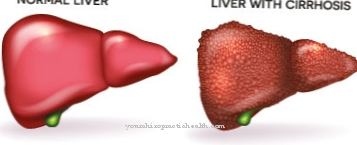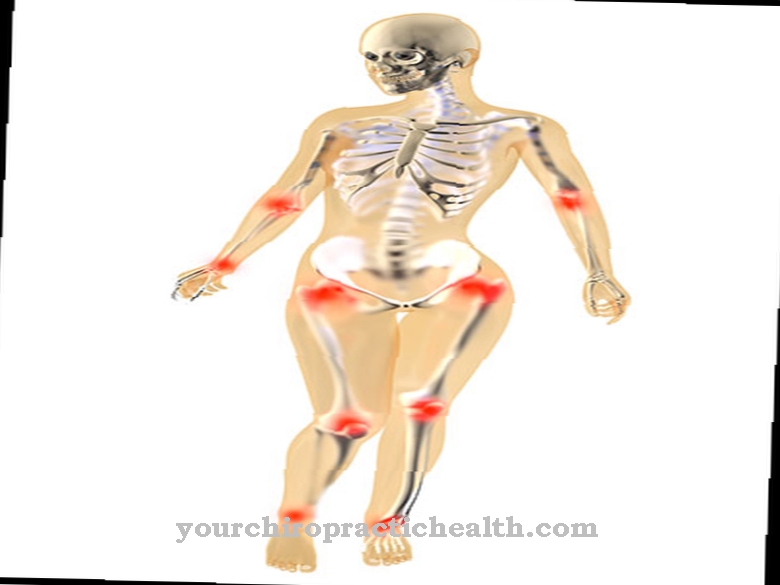myopia causes blurred vision when looking into the distance. A Myopia can have different causes and is treated in different ways accordingly.
What is myopia?
.jpg)
© vectorwin - stock.adobe.com
Myopia is an ametropia in which objects that are far away from the viewer are seen out of focus. With the present myopia on the other hand, things that are close to the viewer are seen clearly.
People who suffer from myopia but do not wear appropriate optical aids (glasses or contact lenses) often have their eyes squinted when looking in the distance; this can improve short-term vision in the case of nearsightedness.
Myopia owes its name to this fact, because the Greek name for nearsightedness is based on the word 'myops'; in German this means something like 'blinking face'.
The degree of myopia is specified individually in the unit diopters; myopia is characterized by diopter values in the negative range, e.g. -0.5 diopters.
causes
One myopia can have various causes. The most common cause of myopia in Germany is an eyeball that is too long in relation to its refractive power (this form of myopia is also known as axial myopia).
In this form of myopia, the light rays falling on the eye are already bundled before they hit the retina, and the image on the retina becomes blurred. Axial myopia as a form of myopia can be hereditary, but is also often observed in people who were born prematurely.
Another possible cause of nearsightedness is too high a refractive power or a curvature of the cornea or lens; This form of nearsightedness is called refractive myopia. This form of myopia is less common in Germany.
Symptoms, ailments & signs
Myopia often shows up in early childhood, less often it only develops in adulthood. The symptoms of myopia are usually such that they worsen over time. This means that eyesight will become increasingly limited over time. With visual aids, however, the progression of nearsightedness can be contained well until finally no further deterioration occurs.
The first signs are usually that those affected unconsciously screw up their eyes when looking at something distant. This comes about by trying to compensate for the inadequate accommodation of the lens by reducing the incidence of light. Correspondingly, this appears for the first time with objects that are far away, and later with objects that are very close.
There are increasing problems with the recognition of faces, lettering and so on. Reading a book, on the other hand, does not cause any difficulties. Illuminated objects are perceived as particularly blurred. If the focus is on distant objects for a long time - for example on a lecture or a television set several meters away - it can lead to [[[headache]] or dizziness. In addition, the eyes can sometimes start to pain.
Myopia are also more prone to perceiving shadows or streaks in their own field of vision. This is due to liquefied components in the eyeball that appear earlier in myopic people than in people with perfectly healthy eyes.
Course of disease
_2.jpg)
A myopia usually develops within the first three decades of life and then no longer progresses or progresses significantly more slowly. In the case of very pronounced myopia, however, there can still be significant deterioration even after the third decade of life.
If myopia is in the form of axial myopia (i.e. if the eyeball is relatively elongated), the greater the strength of the myopia or the longer the eyeball, the greater the risk of the retina thinning.
This can lead to retinal detachment in the case of severe nearsightedness. This also increases the risk of going blind if the retinal detachment is not treated in good time.
Complications
As a rule, myopia does not lead to particular complications for the patient. In most cases, however, there is no causal cure for the disease, which means that patients are dependent on glasses or contact lenses. There is also no self-healing. Those affected suffer from impaired vision due to myopia and can no longer see objects properly.
As a rule, complications only arise if the nearsightedness is not treated and the person concerned does not wear visual aids. The muscles of the eyes continue to be strained so that the ametropia can worsen even further. In the worst case, this can lead to complete blindness of the patient.
In adulthood, myopia can be treated with the help of laser surgery. There are no complications and the symptoms disappear after the procedure. However, it is also possible to wear glasses or contact lenses. The affected person may not be able to carry out certain jobs or activities due to the myopia. However, the life expectancy of the patient is not affected or reduced.
When should you go to the doctor?
A visit to the doctor is advisable as soon as the usual vision deteriorates. If objects or people can no longer be recognized as usual when looking into the distance, a doctor should be consulted. If your own vision is significantly impaired in direct comparison to people in the immediate vicinity, you must report the observations to a doctor. If the vision is blurred or if the targeted contours are only vaguely recognized, an eye test provides information about the existing impairments. If eyesight suddenly or gradually deteriorates, there is cause for concern. A doctor should also be consulted if the ability to see far is only sporadically impaired.
Stress triggers, the use of medication, or other causes can lead to temporary myopia. In order to avoid permanent damage, it is advisable to visit a doctor for a check-up.If the person concerned suffers from insomnia, headaches or experiences pain in the eye, a doctor's visit is required. If you feel pressure in your head, have an inner restlessness, a decrease in concentration or performance, a doctor should be asked for advice. If the abnormalities of reduced vision occur despite the presence of a visual aid, a doctor must be consulted. Corrective adjustments are necessary to prevent further deterioration in vision.
Treatment therapy
_3.jpg)
myopia can be treated in different ways. One possibility is to use optical aids (glasses or hard and soft contact lenses). Lenses used for myopia are diverging lenses. They are characterized by a negative refractive power. So-called OK contact lenses can be used against mildly developed myopia; they can temporarily flatten the cornea slightly.
Further treatment options are (depending on the type of myopia present) surgical interventions to correct myopia; In axial myopia, surgery can take place, for example in the form of a laser treatment. One of these procedures is the LASIK (laser in situ keratomileusis) procedure.
A narrow layer of the cornea is lifted with a scalpel and folded upwards; Subsequently, in the case of myopia, fine parts of the center of the cornea are vaporized by laser, so that incident light is only focused on the retina and thus sharper vision is possible. The procedure is usually carried out on an outpatient basis and takes a few minutes. An improvement in distant vision is often noticeable after a few hours.
The chances of success of completely compensating for myopia are usually higher, the less myopia is pronounced.
You can find your medication here
➔ Medicines for visual disturbances and eye complaintsOutlook & forecast
Myopia offers a relatively good prognosis. Myopia can be completely eliminated with visual aids and surgical interventions. Affected people have the option to undergo laser treatment or take other measures to reduce myopia.
The prognosis is worse if the myopia occurs as part of a chronic disease that is progressing. Myopia can be treated symptomatically in the case of a hereditary disease, but the ability to see continues to decline. The patient eventually becomes completely blind. This significantly reduces the quality of life, as previous activities can no longer be carried out. Often the job has to be changed and there are financial burdens because the health insurance company does not cover the consequences of a sudden illness.
In general, however, the prognosis for nearsightedness is positive. If the person concerned wears a visual aid or is undergoing an operation, normal life is possible. Myopia does not affect life expectancy. In the case of congenital myopia, laser treatment or other types of surgery are often not possible. Those affected are mostly dependent on visual aids. However, this is at best a visual flaw and usually does not result in any further health problems.
prevention
There are few ways of one myopia effective prevention. Depending on the form of myopia, however, possible consequences can be prevented (for example, in the case of severe myopia, a regular visit to the ophthalmologist can help prevent or remedy a detachment of the retina at an early stage); The course of some forms of refractive myopia can be positively influenced by consistent treatment of the underlying problems (e.g. cataracts).
Aftercare
The purpose of follow-up is the early treatment of a recurring disease. This is known from tumors, for example. With myopia it is different. It is permanent and therefore cannot appear repeatedly. In addition, it is not a life-threatening disease. Follow-up care is more aimed at supporting the person affected in their everyday life and preventing complications.
This is primarily done by providing suitable aids such as glasses and contact lenses. Sufficient eyesight is not only a prerequisite for participating in road traffic, but is also essential for almost all areas of life. However, since changes in vision are not uncommon in the course of life, ophthalmologists recommend an annual check-up.
This will also clarify other secondary illnesses. The acute scope of the complaint forms the basis for the scope of an investigation. There is now also the possibility of an operative correction. The result of such an intervention cannot always be predicted.
If the desired goal in the form of one hundred percent vision is achieved, aftercare is no longer necessary in the long term. The patient only turns to an ophthalmologist in the event of acute loss of vision. In the event that surgery does not achieve the desired effect, visual aids must still be used.
You can do that yourself
If intensive, lengthy eye work cannot be avoided, temporary relaxation of the eye muscles helps. Affected people should occasionally look to a point in the distance. This changes the curvature of the lens, the eyes are newly "adjusted" and temporarily relieved. When working on the computer, a minimum distance of 50 cm from the monitor is recommended. Numerous settings such as an optimally selected contrast, an enlarged display of the objects and selectively selectable magnifying glasses make it easier for nearsighted people to work at the screen. In extreme cases, a Braille keyboard is recommended. Special computer programs read screen texts aloud, in free time audio books or audio magazines do not need to be read by yourself.
In everyday domestic life, a strict order and good labeling of objects prove their worth. Those affected can mark sharp, pointed or fragile utensils with marking tape in bright colors. Marking points in different colors, shapes and sizes help on electrical devices such as cookers or washing machines. With their help, switch settings can be felt. In order to avoid serious mix-ups of medication, there are medication dispensers from the pharmacy. Relatives can put the required daily dose in there. In the case of harmless substances, for example beverages or food, it helps to use other sensory perceptions. Much can be recognized by its texture, size, weight and smell. Glare-free, flicker-free light supports the view.
There are special services for the visually impaired in public spaces. For example, some airlines offer escort at the airport. Visually impaired rail travelers can book a transfer aid in advance and many timetables have a text mode.


.jpg)





















.jpg)



